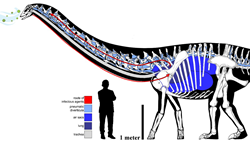
The elaborate and circuitous pulmonary complex of the sauropod, with the hypothetical route of infectious pathway in MOR 7029. Source: Woodruff et al. (2022) and Francisco Bruñén Alfaro.
“This fossil infection in ‘Dolly’ not only helps us trace the evolutionary history of respiratory-related diseases back in time, but gives us a better understanding of what kinds of diseases dinosaurs were susceptible to.” – Cary Woodruff, PhD, of the Great Plains Dinosaur Museum in Malta.
POMONA, Calif. (PRWEB)
February 10, 2022
The fossilized remains of an immature diplodocid – a large, long- necked herbivorous sauropod dinosaur, like “Brontosaurus” – may provide the first evidence of a unique respiratory infection in a dinosaur, according to a study published in Scientific Reports. The findings increase our understanding of the illnesses that affected dinosaurs.
The specimen, nicknamed “Dolly,” was discovered in southwest Montana, USA, and dates back to the Late Jurassic Period of the Mesozoic Era (approximately 150 million years ago). Cary Woodruff, PhD, of the Great Plains Dinosaur Museum in Malta, Western University of Health Sciences Associate Professor Mathew Wedel, PhD, and their colleagues examined three of the cervical vertebrae (the bones from the neck) from “Dolly” and identified never before seen abnormal bony protrusions that had an unusual shape and texture. These protrusions were located in an area of each bone where they would have been penetrated by air-filled sacs. These air sacs would have ultimately connected to “Dolly’s” lungs and formed part of the dinosaur’s complex respiratory system. CT imaging of the irregular protrusions revealed that they were made of abnormal bone that most likely formed in response to an infection.
“Given the likely symptoms this animal suffered from,” Woodruff said, “holding these infected bones in your hands, you can’t help but feel sorry for ‘Dolly.’ We’ve all experienced these same symptoms – coughing, trouble breathing, a fever, etc. – and here’s a 150-million-year-old dinosaur that likely felt as miserable as we all do when we’re sick.”
Based on the location of these abnormal bony protrusions, the researchers suggest that they formed in response to a respiratory infection in “Dolly,” which ultimately spread into these neck vertebrae via the air sacs and caused the irregular bone growths. The authors speculate that this respiratory infection could have been caused by a fungal infection similar to aspergillosis, a common respiratory illness that affects birds and reptiles today and can lead to bone infections. In addition to documenting the first occurrence of such a respiratory infection in a dinosaur, this fossilized infection also has important anatomical implications for the respiratory system of sauropod dinosaurs.
“This fossil infection in ‘Dolly’ not only helps us trace the evolutionary history of respiratory-related diseases back in time,” Woodruff said, “but gives us a better understanding of what kinds of diseases dinosaurs were susceptible to.”
The researchers suggest that if “Dolly” had been infected with an aspergillosis-like respiratory infection, it likely experienced flu or pneumonia-like symptoms such as weight loss, coughing, fever, and breathing difficulties. As aspergillosis can be fatal in birds if untreated, a potentially similar infection in “Dolly” could have ultimately caused the death of the animal, they add.
“This tells us more about respiratory diseases themselves. The kinds of respiratory diseases that we get, and that birds get today, have been around a long time,” Wedel said. “We are seeing this disease process in air-filled bones that are a long way up the neck from the lungs. So that confirms something we suspected, that the air spaces that connected the skeleton to the respiratory system in dinosaurs were similar to what we see in living birds. An animal the size of a school bus from the Jurassic Period, and a chicken from someone’s backyard – under the hood, they look basically identical, and were subject to the same diseases.”
In addition to Woodruff, the research team included a paleopathologist/veterinarian—Ewan Wolff, PhD, DVM, DACVIM (University of New Mexico), a veterinarian—Sophie Dennison, BVM&S, MRCVS, DACVR, RCVS (TeleVet Imaging Solutions, Oakton, VA), and two paleontologists who are also medical anatomists— Dr. Wedel (who is an associate professor in WesternU’s College of Osteopathic Medicine of the Pacific and College of Podiatric Medicine, Pomona, CA), and Lawrence Witmer, PhD (Ohio University Heritage College of Osteopathic Medicine, Athens, OH).
“This is a great example of interdisciplinary science – respiratory disease in a 150-million-year-old dinosaur. You need more than one person’s expertise to figure all that out,” Wedel said. “It was a really great collaboration, and we’re already thinking about what projects we can do next.”
The final article, this news release, and related images can be downloaded from the following Dropbox link: https://bit.ly/3IWPCTG
Share article on social media or email:

